Ch 8: K9 Games®
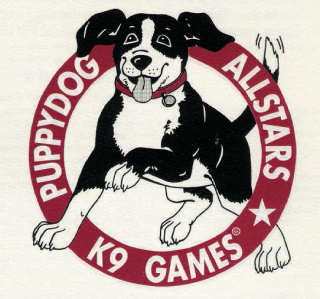
— The Ultimate Dog Show —
Over the past few years, television has gone to the dogs! Dogs have become more and more prominent in the media, movies and sitcoms. Puppy dogs have a proven “Ahhhhh!-factor” and are used to advertise numerous products from cars to beer. In England dogs even advertise toilet tissue! Dogs have everything. The time has come for dogs to advertise themselves!
Twenty years ago, I predicted, that dog events (especially Dog Dancing) would become the next big-money TV sport, in much the same way that Figure Skating (skating repetitive figures) has evolved into Ice Dancing. It is just begging to happen.
The K9 GAMES® is a fast-moving, fun-filled, action-packed, doggy extravaganza with puppies and dogs, children and adults all having a great time. Winning is only the tertiary reason for competition. The secondary reason for competition is to entice spectators to want to train their dogs the dog-friendly way. At all times K9 GAMES® competitors are ambassadors for dogs, and for dog-friendly dog training. The primary reason for competing is for people to have fun with their dogs. Indeed, laughter and giggles, and woofs and wiggles are the hallmark of the K9 GAMES®.
The K9 GAMES® bring back some sparkle, some excitement and razzle-dazzle to pet dog training, by providing an organized forum to motivate owners to want to train their dogs using easy and enjoyable, dog-friendly dog training techniques. All events are designed to improve the quality of the relationship between dogs and people and each individual event, (including doggy-dashes, retrieval races, woof relays and the signature event — doggy dancing), is specifically designed to fine-tune essential ingredients of a pet dog's training repertoire.
The K9 GAMES® showcases dog-friendly dog training — showing people having fun with their dogs and dogs having fun with their people. The K9 GAMES® provides educational entertainment to an ever-expanding audience, which is all but begging for more dog-related good times. People love to laugh. People and dogs love fun, action, athleticism, competition, excitement and family events. People are seduced by game shows and repetitive sporting activities. (In England, show jumping and sheep herding competitions are prime time viewing!) People even enjoy watching the variety of different breeds stand around and look pretty at conformation dog shows. The K9 GAMES® offers all of the above and much more.
The K9 GAMES® is a team competition with each team having a maximum of nine dogs and nine handlers. The teams compete in nine games: Musical Chairs, Doggy Dash, Kong Retrieve, Distance Catch, Take & Drop, Joe Pup Relay, Recall Relay, Woof Relay, and the K9 GAMES® signature event — Waltzes with Dogs
In the pursuit of proofing, reliability of performance and surprise in competition, K9 GAMES® Rules may be changed at any time during a competition and certainly, from event to event. The K9 GAMES® were initially held in 1995 at Fort Mason in San Francisco. In subsequent years they have been held in Long Beach (‘96), Upper Marlboro MD (’97), Toronto (’97, ’98 & ’99), England (’03, ’04 & ’05) and Japan (’05 ’06 ‘07).
Musical Chairs
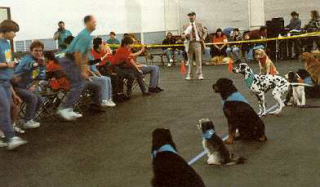
Musical Chairs is a doggy variation of the classic children’s game. Music plays as handlers walk with their dogs off-leash counter-clockwise around a rectangular area. A line of chairs (with alternating chairs facing in opposite direction) runs down the centerline of the rectangle. When the music stops, the handlers instruct their dogs to sit by verbal request and/or hand signal only, (i.e., without touching them), and rush to sit on a vacant chair in the center of the rectangle. Musical chairs is meant to be a non-contact sport; with the exception of two human rear ends making contact when attempting to sit simultaneously on the same seat, physical contact with any dog or other competitors is not allowed.
The dogs must remain in sit-stays outside of the rectangle. If a dog breaks his sit-stay, or if any part of the dog’s body causes a Line Fault by cutting the line of the rectangle, (paw-faults and tail faults included), the handler must vacate their chair and completely leave the rectangular area to re-sit their dog without contact before trying to find an empty chair once more.
There are always fewer chairs than handlers. The chair-less handler may attempt to get other dogs to break their sit stays by sweet-talking, calling, offering food treats, and by generally acting silly. However, the handler must not use any dog’s name and they must not touch or frighten any dog. Once all of the chairs are occupied by handlers whose dogs remain in sit stays outside of the rectangle, the handler left standing is eliminated. One chair is removed from the line and the next round begins. The top two qualifiers from each round go into the Final.
Training Tips
Playing musical chairs teaches dogs two of the most useful pet dog skills — a lightning-fast, off-leash, emergency Sit plus a rock-solid Sit-Stay. When dogs are successful at playing Musical Chairs, they will take a quantum leap in terms of their quality of life because when owners have such a high degree of off-leash control, they are much more likely to take their dogs to dog parks and on off-leash walks.
Also, dogs with prompt and reliable Sit-Stays are likely to be given full-run of the house, rather than being locked away when visitors arrive. Dogs with reliable Sit-Stays are just much more fun to live with. A quick Sit and solid Stay prevent or resolve well other 90% of possible behavior and training problems because sitting and misbehaving are usually mutually exclusive activities. For example, your dog cannot jump-up, chase his tail, chase the cat, practice agility in your living room, dash out the front door, or lunge on leash and sit at the same time. When in doubt, just say, “Sit!”
Musical Chairs is played off-leash and handlers are not allowed to touch their dogs, so that owners are encouraged to achieve verbal, off-leash, and distance control over their dogs. If owners were allowed to tug on the dog’s leash to encourage him to follow, or to push on the dog’s rump to prompt or coerce him to sit, they would come to rely on leash-tugs and rump-pushes and so, would have no control over their dog if he were off-leash and out of hands reach. When a dog is off-leash, at a distance and looking away from his owner, verbal control is essential.
To gain a competitive edge in Musical Chairs, heel your dog on your right-hand side to keep him as far away from the rectangle when walking counter-clockwise, then he will be less likely to cause a Line Fault when you hustle towards the chairs when the music stops. Whereas, if your dog heels on your left, he will likely sit very close to the Fault Line of the rectangle.
In the earlier rounds, ask your dog to sit and make sure he is in a solid-stay before calmly walking to the line of chairs. In the earlier rounds, a chair will always become available. Dogs will likely be breaking sit-stays every which way but loose. The goal is to qualify for the Final. However, in the Final, your dog will need to sit immediately after the music stops and you give the command while running for a chair. Lure/Reward training is by far the best way to achieve such speedy distance control.
When first watching Musical chairs, many people ask whether it is fair for the chair-less competitors to try and get other dogs to break their Sit-Stays, especially when the chair-less people call the dog, “Puppy, come here,” when they say and signal “Down!” and when they enticingly waggle or toss a food treat. Of course it’s fair! Not only is it fair, but also, ultra-proofing a dog’s Sit-Stay is one of the most important training exercises. For example, let’s say your dog is off-leash in the dog park and suddenly, you notice that some unthinking owner is holding the gate wide open and your dog is rushing towards the street. You instantly shout, “Rover, Sit” and your dog immediately and obediently screams to a halt in a Sit-Stay. However outside the park a little girl is calling her dog in a sweet voice, “Come here, Molly. Come on puppy. Come and get a cookie.” Do you want your dog to remain in a Sit-Stay, or run out of the park to the little girl? Obviously, we would like the do g to remain in a Sit-Stay, that’s why we proof dogs to respond only to commands, that are preceded by their name and to ignore all others. When you instruct your dog to Sit-Stay, you do not want him to respond to other people. Similarly, if you live with more than one dog and say, “Rover, Sit. Fido, Come,” you want Rover to sit and Fido to come, not vice versa. A dog has a name for a reason and so; let’s use it prior to every command where a reliable response is essential.
Doggy Dash - Racing Recalls
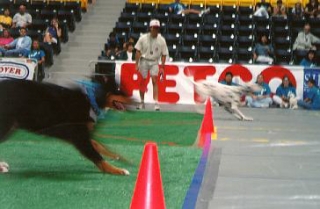
Pairs of dogs race against each other and the winning dogs go through to the next round. Each dogs is held at the Start Line by a steward who releases the dog as soon as the judge says, “Ready, steady go!” The first dog to sit across the Finish Line wins and goes through to the Second Round. Dogs are disqualified if they leave their racing lane. Winning dogs from the Second Round go through to the Quarter Finals. Eventually, two dogs compete in the Final to determine who is the fastest dog of the competition.
Training Tips
Slow recalls and no recalls are quite common with many pet dogs. Unless numerous short training interludes have been thoroughly integrated into the dog’s off-leash investigation and play (by frequent come here/go play, come here/go play sequences), for many dogs, “Come Here” usually signals the end of an otherwise very enjoyable off-leash romp. And of course, it doesn’t improve matters that the contorted-faced owner is screaming, “COME HERE YOU MISERABLE CUR!!!”
On the other hand, prompt and fast recalls are seldom a problem for dogs that compete in the Doggy Dash. The handlers become extremely lively and animated and so not surprisingly, the dogs come flying at warp speed. The dog now has good reason to come when called to his happy owner and will be more than praised when he gets there. In fact, in the Doggy Dash most dogs come so fast that a reliable recall is pretty much a given. Winning this game is all about teaching your dog to sit quickly. So many times I have seen the first dog to cross the Finish Line come second, because he shot through the owner’s legs, circled, barked and jumped up.
Increase the speed of your dog’s sit by practicing multiple, short come-sits and differentially reinforcing only the quicker sits. Take one step back and then instruct and signal your dog to Come and Sit. Repeat this sequence 20 times with ten pieces of kibble and three pieces of cheese or liver in your hand. Give no feedback to your dog if you have to repeat the verbal command or hand signal. Similarly, give no feedback for slow Sits. Only praise your dog and offer a single piece of kibble for the faster Sits. And for the fastest Sits… celebrate as if your dog has won the Olympics, praise, hug, jump up and down and offer one or two pieces of cheese or liver.
When competing, your timing is crucial. Stand on the Finish Line when calling your dog and hold your signal hand out in front as a point of focus for the dog. As your dog crosses the halfway point, back up across the Finish Line (be careful not to fall over when running backwards) and shout and signal Sit just as your dog is two dog-lengths from the Finish Line. A seasoned competitor will dash towards you and slide across the Finish Line in a Sit-Stay.
Additionally, it is vital that your dog understands the whole point of the game — to come as quickly as possible and to be the first dog to sit across the Finish Line. It is essential that your dog understands the concept of Fast vs. Slow and it is advisable to instill a desire to win in your dog!
Even though you are going to jump up and down and scream like a banshee to get your dog to come as quickly as possible, we want to teach the dog to understand that this is a race and that urgency is essential. Whereas it makes sense to teach a slow dog to move faster, very few owners appreciate that a very fast dog can also be taught to move even faster. Training fast dogs to move faster can be quite difficult, unless you first teach your fast dog to move slowly, then the change in pace between slow and fast is quite dramatic and much more obvious to the dog and therefore, easier to put on cue.
You may train your dog while walking him on-leash. Walk in a straight line and periodically adjust your speed through three gears — very slow, normal and very fast. Your dog will soon begin to adjust his pace accordingly. Now we are going to put the dog’s change of pace on cue.
When you are walking very slowly, 1. Say, “Rover, Quickly” or “Rover, Hustle” (you may chose to use whichever verbal command you prefer… instruct your dog in French or Italian if you wish), 2. Abruptly change pace from very slow to very fast, and as soon as… 3. Your dog changes pace accordingly, 4. Praise and reward your dog. And then, when you are walking very quickly, 1. Say, “Rover, Slowly” or “Rover, Steady,” 2. Abruptly change pace from very fast to very slow and as soon as… 3. Your dog changes pace accordingly, 4. Praise and reward your dog. Repeat this training sequence a dozen or so times, and you will find your dog will speed up when you say “Rover, Quickly” and slow down when you say “Rover, Slowly.”
Now call your dog and when your dog is running towards you at Warp Factor Nine, say “Quickly! Quickly!! Quickly!!!” and you will discover that he has an extra, ultra-hyper-mega turbo drive.
Now, it’s time to teach your dog to have an overwhelming desire to win, so that he will offer that little bit extra when in competition. Practice with another handler and dog plus two dog holders. Race both dogs against each other and reward them differentially, according to who comes first and who comes second. Praise the second place dog and let him sniff a liver treat but not eat it. Celebrate with the winning dog and give him three liver treats. By staggering the starts it is easy to set it up that each dog wins 50% of the time. Periodically race and time the dogs over the standard 49-yard distance and you will see their times improve from week to week.
Kong Cup Challenge
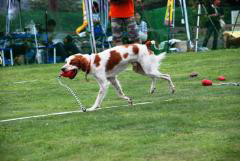
In one of the most exciting and fast-paced games, dogs have just one minute to accumulate as many points as possible by retrieving chewtoys of different point values from an enclosed retrieval area. Light-blue (water) Kongs are valued at 5 points, red Kongs at 3 points and black Kongs 1 point. The handler stands in a two-yard square Handler's Box within a five-yard square penalty box. In order for points to score, the handler must be able to take or pick up the object (with at least one part of their body remaining grounded in the Handler's Box) and place it in a plastic bucket. If the dog brings back a Bonus Kitty (soft toy) the final score is doubled, whereas if the dog’s paw enters or cuts the line of the Penalty Box while he is carrying a Penalty Bone in his jaws, the final score is halved. Retrieving a Kong Biscuit Ball increases the allotted retrieval time by 15 seconds. The dog with the highest score wins.
Training Tips
Practice as a group in many different places, with other dog’s Kongs and make sure to teach your dog discriminated-retrieves, i.e., your dog needs to be trained to reliably retrieve a Kitty or a blue Kong when requested.
Many owners fall into the comfortable trap of only training in familiar settings with familiar objects — the dog’s own Kongs. When it comes time to compete, the dog spends the entire minute running round the arena sniffing each Kong in turn looking for his own, and the final score is zero. It is important to practice with other dog’s Kongs and to do so in a variety of settings — in different people’s homes and yards and in parks and on walks. It is essential that your dog is as reliable in the arena as he is at home. Walk your dog with friends and their dogs and every 25 yards each person puts down a Kong for another dog to retrieve.
Many handlers think that it is sufficient to compete with a “retrieving fool” — a high-speed retriever who simply lives to retrieve and will bring back object after object non-stop. Usually they fair pretty well in competition because they bring back so many objects. However, sometimes their tally consists of toys with a low point value, or even Penalty Bones. For example, the dog may bring back ten objects within the one minute period — six black Kongs, two red Kongs and two penalty bones, the total score is only 3 points. Compare this to a dog (competing in the Toronto Sky Dome), who picked up three stuffed Kitties and shoveled the fourth Kitty back to his handler on his very first run. This meant that his next three retrieves — three blue Kongs — were each worth double-double-double-double 5 points (80 points) for a total score of 240.
To win this game your dog needs to be taught which specific objects he should retrieve. Teach your dog discriminated-retrieves in the same way that you would teach your dog to find your lost keys, or the remote control for the television.
Dogs that compete successfully in Kong Retrieve become absolutely Kong crazy and seldom become destructive chewers or excessive barkers when left at home alone. They have become Kongaholics and would much rather lie down and chew their food-stuffed Kongs than destroy the house or bark all day. Also, dogs are taught not even to touch, let alone pick up, forbidden articles, such as Penalty Bones but instead, to redirect their retrieving urges to Kongs.
Distance Catch
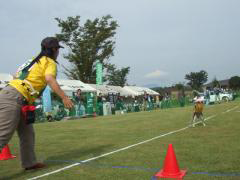
Each handler has three attempts to throw an object of their choice (ball, toy, bean bag, Frisbee, etc.) for their dog to catch. All competitors take their first throw, before the Second Round of throwing. In both the Third Round of throwing and in the Final, the competitors throw in reverse order to the current standings, i.e., the competitor with the shortest distance throws first and the competitor with the longest distance in the first two rounds throws last. Prior to each throw, the dog may wait at any point in the arena, or the handler may instruct their dog to stay at a specific location. The owner must remain behind the Throwing Line before throwing the object and until a Fair Catch has been signaled by the judges. For a Fair Catch, the dog must catch the object using jaws and/or paws before the object touches the ground and after catching the object, the dog must land with all four paws inside the four-yard wide Catching Lane. The dogs with the eight longest Fair Catches qualify for the Final.
Training Tips
Aside from dog training tips, there are some obvious human requirements for this game. Considerable thought should be given to the choice of object, handlers should practice throwing straight and increasing the distance of their throws, and handlers should address the strategy of the game.
Choose an object that is safe. Also, the choice of object will strongly influence accuracy, distance and ease of catching. The owner should try to throw the object on as low a trajectory as possible High throws go a long way up and a long way down but not too far horizontally. Also, with high throws, the dogs often lose the object in the arena lights. Tennis balls tend to bounce out of the dog’s jaws. Soft toys are easy to catch but too light to throw great distances and are much more difficult to throw accurately. In one competition a handler threw a soft toy so high, that it caught the air currents and landed behind them! Frisbees travel the greatest distance, but require greater expertise to throw accurately. A beanbag with a rope tail is one of the easiest objects for the dog to catch and it may be thrown accurately and over great distances with a low trajectory.
Distance Catch is a strategic game, similar to a long jump competition. When starting the Second and Third Round of throws, each competitor is aware of the standings and knows exactly where to place their dog to qualify for the Final. Similarly, in the Final, each competitor knows exactly where to place their dog to win first, second or third place. Aside from the ability to catch the object, a solid and attentive sit-stay is the secret to success when positioning the dog at a specific distance within the Catching Lane. Many dogs will walk back towards their owners after being positioned and even if they catch the object, the distance is much less than the handler had hoped for.
Take and Drop
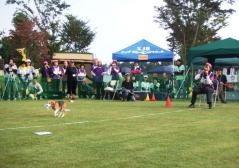
Within the allotted one-minute time period, the dog must take an article from the handler and follow the handler’s directions, so as to drop the article as close as possible to a $100 bill, which is taped on the floor approximately 30 feet away. The article (usually a squeaky and/or soft toy) is supplied by the judge and is the same for each dog in any competition but is different for each competition. While giving directions to the dog, the handler must remain seated at all times. The handler is disqualified if the judge can see daylight between the handler’s butt and the chair. Once the dog has placed the object to the handler’s satisfaction, the handler raises an arm and shouts, “Mark!” and the distance is measured. The area is littered with other paper markers, so that it is not a practical strategy simply to teach the dog to go to a single and obvious marker. Instead, to compete successfully in the Take and Drop, the dog needs to be taught to take precise directions from the handler.
Training Tips
Take & Drop is by far the most difficult event in the K9 GAMES because the dog’s performance has to be so precise in an arena with many distractions, including many people and dogs, numerous dropped food treats, music playing and spectators laughing and clapping. A dog that competes successfully in Take & Drop is simply an extremely well-trained dog — an advertisement that he has the good fortune to live with and extremely talented dog handler.
Many dogs become very adept at this game when playing with own toy in their own back yard or in a familiar park, yet they fail in competition. Indeed, a surprising number of dogs even fail to take the object from their handler. Some dogs take the object but fail to leave, and spend the entire minute sitting by the handler’s side. Other dogs eagerly take the object and work well for a while but then become distracted and drop the object and fail to pick it up again. Perhaps even more frustrating are dogs that take the object and follow the handler’s directions to go and sit by the $100 bill, but then fail to drop the object. The object must be on the floor and the handler must shout, “Mark!” before the distance can be measured.
When offered an unfamiliar object, especially in an unfamiliar place, most dogs want to thoroughly investigate the object before taking it. In unfamiliar places, many dogs want to remain close to their handler.
Aside from teaching your dog directional commands, you also need to teach your dog to take any article on command, to pick-up and drop any article at a distance and to do so in a wide variety of settings.
Gun dog trainers usually teach the dog to run out in a straight line and at the sound of a whistle to sit facing the handler to take further directions for left/right and back/forward. For Take and Drop, I much prefer to train dogs to walk backwards. Aside from the fact that this is hilarious to watch, having the dog walk backwards allows for more precise directions because the dog walks slowly and can always see the handler’s hand signals to go back, right/left, sit, or lie down. Additionally, it is a huge advantage to teach the dog to move slowly on cue, especially when instructing the dog to come closer.
The best way to proof for different objects and environments is to train with a friend on a walk. Have the friend bring half a dozen or so different objects for your dog, and you bring half a dozen for their dog. Every 25 yards, stop and train; ask your dog to take the object (from your hand) and to carry, drop and retake the object (from the ground). Tie the dog’s leash to a tree and instruct the dog to pick up and drop the object at a distance. Now practice the entire Take and Drop in a variety of safe settings, indoors, in a friend’s yard and dog parks. Have specific criteria. Choose specific places in the environment to send your dog. For example, direct your dog to go and lie down on a specific spot on the living room carpet, or on a specific floor tile in the hallway. Or, instruct your dog to go and sit by a specific tree or bench in the park. Or, instruct your dog to take and drop the object next to a flower or fallen leaf on the grass.
Joe Pup Relay
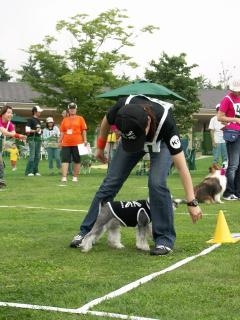
Each team consists of one dog and four handlers. Two teams compete at a time and the winning team goes through to the next round. Dogs race in individual lanes and run from person to person, performing a different obedience routine with each handler stationed at each of four stations. The exact nature of the routines to be performed at each station is only made known to competitors on the morning of the competition.
Training Tips
I designed the Joe Pup game in 1989 at the request of the owner of Blue Springs Dog Training Center in Colorado to help prepare nervous handlers for competition by teaching them to think quickly under pressure while performing extremely complicated and varied routines. In the original Joe Pup Relay, each handler (plus dog) raced one-at-a-time against the clock. The handler started at Home Plate and raced around a baseball diamond performing a different, recently-learned, complicated obedience routine at each base. The game was an instant success and so I adapted it for use in SIRIUS® puppy classes.
For pet owners, each base represented a virtual reality pet dog training scenario. Starting with their dog in a Sit-Stay on Home Plate, the owner had to run to First Base, which represented a veterinary clinic and the dog had to perform a Sit-Down-Sit-Stand-Down-Stand sequence to prepare him to Down-Stay in the waiting room, Sit on the scale and Stand for examination. Second base represented a Range Rover and the dog had to jump-up on a platform and remain in a Sit-Stay while the owner placed two grocery bags (with dog treats) beside the dog, circled the platform twice singing How Much is That Doggie in the Window (don’t ask me why) and then sit in a chair for ten seconds with their back to the dog. Third base represented the TV room couch and the owner had to lie down on the floor (couch) and then instruct their dog to lie down (so they could see the TV) for a count of five “Good dogs.” Then the owner had to run back to Home Plate, ask their dog to sit and tap him on the head.
In the early 90s we randomized the exercises at each base, by asking each owner in class to teach their dog a new trick or training sequence and to write the routine on a card. All the cards were put in a hat and each competitor would draw three cards for their round. Sometimes they would pick a routine that their dog didn’t know yet. Well, you’re racing against the clock and so… train that do g NOW! We found that this format gave owners lots of confidence and that rather than making excuses for what their dog didn’t know, they just trained their dog on the spot.
By playing Joe Pup in the K9 GAMES format with one dog and four handlers, now the dog’s owner has to learn the pet dog trainer’s role — how to teach other people to handle the dog that you have already trained. This of course prepares families for living with dogs. Dog owners learn how to teach other family members and friends to work with the dog that they have already trained.
To successfully compete in Joe Pup, all you need an ultra-socialized dog, who is perfectly willing to work with a variety of people plus three other people, who can improvise when the pressure’s on. To avoid confusion, only one person should instruct the dog at a time. It is especially important that the owner does not talk when other handlers are working with the dog, otherwise the dog will ignore the handler and run back to his owner.
Recall Relay
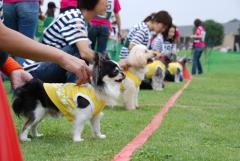
Two teams of four dogs race against each other and the winning team goes through to the next round. Dogs may be instructed to Sit Stay, or be held by other team members behind the Start Line, while the handlers walk across the arena to stand behind the Finish Line, facing their respective dogs ten yards away. Most teams elect to have holders, because after three false starts, the team is eliminated. Also the dog holders may amp-up the dogs prior to a catapult release.
After the judge, says, “Ready… Steady… Go!” the two handlers (from opposing teams) at either end of the line call their dogs first. Each dog is required to come and sit (entirely across the Finish Line, whereupon the handler taps the dog on the head as a signal for the next handler in line to call their dog. When the fourth handler has tapped the dog on the head for sitting, all handlers instruct their dogs, “Down!”
Training Tips
All dogs need to be super-friendly and confident around people, because they are held by other team members at the Start Line. As in the Doggy Dash, fast and reliable recalls are pretty much taken for granted. To gain the competitive edge, team members want to teach their dogs quick Sits and Downs and learn to pay attention to what their team members are doing.
This game is pretty simple, yet so many teams disqualify. Holders let go of dogs too soon. Handlers call dogs too soon or forget to tap the dogs on the head. One handler forgot to Down his dog at the end and lost the race for his team.
The Recall Relay is all about awareness — paying attention to what other dog handlers are doing with their dogs and what you should be doing with yours. Recall Relay handlers become safer handlers; when walking their dogs, they are very quick to get the dog to come and/or sit should the safety or distracting nature of the environment change for the worse, for example, if children are approaching, or if other dogs or animals are on the loose.
Woof Relay
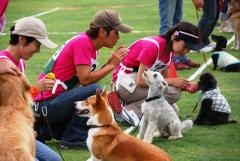
The Woof Relay is a timed event; each team, comprising five dogs and five handlers, competes one-at-a-time against the clock. Each dog has to woof three times and then shush. The team with the shortest total time for 15 woofs wins.
Training Tips
First, you need to teach your dog to speak on cue. Your dog might bark eventually, especially if you do all sorts of silly things, like jump up and down, roll on the floor, sing, or bark at your dog. But that won’t fly for this competition. The Woof Relay World Record is 7.11 seconds for 15 woofs by the Dealing With Dogs team in the Toronto Sky Dome (1999). What you need for this game is a dog who instantly barks three times when you say “Speak!” anytime, anywhere. You need to teach your dog to speak on cue in a variety of different settings and to objectively test your dog’s reliability. Walk your dog and every 25 yards say, “Speak!” (Just once). Note the percentage of times your dog barks following a single request and how long it takes for your dog to bark three times on each occasion.
The wonderful bonus of teaching your dog to Woof on cue is that Woof Relay dogs seldom become problem barkers. Teaching your dog to speak on cue enables you to teach your dog to shush at times that are convenient to you. For example, it is inconvenient and difficult to teach your dog to shush at 3:00am when you’re asleep and your dog is bent out of shape because a raccoon is raiding the trash. Instead, relax, say, “Speak,” praise your dog for woofing and then, 1. Say, “Shush! and immediately, 2. Waggle a piece of Liver Biscotti under your dog’s nose. As soon as your dog sniffs the Biscotti, 3. He will stop barking and so, 4. Calmly praise him, “Good shush one. Good shush two. Good shush three… and so on and then, eventually give him the treat. Repeat the Woof/Shush sequence over and over.
After teaching dogs to “Speak” and “Shush” on cue, owners may further teach their dogs to shush when people walk by the house, to bark should people step on the property, but to shush again as soon as people are invited indoors. One of my dogs (who used to be a serious problem barker) used to love this game and would sit for hours looking out of the front window, silently observing passersby, just daring them, or maybe willing them, to step on our property. Several of my neighbors told me that they appreciated this dog, because he always told them if anyone was going door-to-door.
Waltzes with Dogs - Doggy Dancing
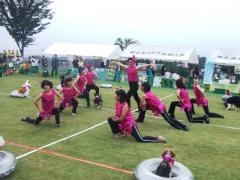
Each owner performs a unique choreography set to music. The various routines are marked out of 10 by a panel of five celebrity judges for both Technical Merit and Artistic Impression. The only rules are that the handler(s) has only 30 seconds to “set up” props and that the performance should last less than three minutes. The rest is left to the handler’s and dog’s creativity and imagination. Waltzes With Dogs is the signature event of the K9 GAMES.
Training Tips
Waltzes with Dogs is all about a close and special relationship between a dog and owner, who both thrill in having a good time together and entertaining spectators. Both dog and handler alternate between leading and following, each adjusting to the other to cover up mistakes. In this event, other competitors, spectators and even the judges smile and clap and laugh out loud when they see the amazing connection between handler(s) and dog(s). Handlers come up with the most creative and captivating routines, often moving, sometimes quite bizarre, but always a joy to watch. I won’t attempt to explain, just watch the videos.
Coordinated group performances are usually pretty hard to pull off, especially with an obedience drill team format because if just one dog makes a mistake, it stands out like a sore thumb. Groups need to practice, practice, practice until perfect and then pray that the performance will still be perfect on the day. One dog/one handler performances are usually easier to pull off because it is easier for handler and dog practice more often and easier for them to cover up mistakes during the final performance. However, recently, several Japanese teams have come up with unique group choreography, with each handler performing different (often pretty crazy) routines.
But regardless of the competition, dancing with your dog is simply the best of activities — a wonderful way to wind down after a hectic day at work. Just be yourself. Relax. Let go. Enjoy your dog. It only takes two to tango!